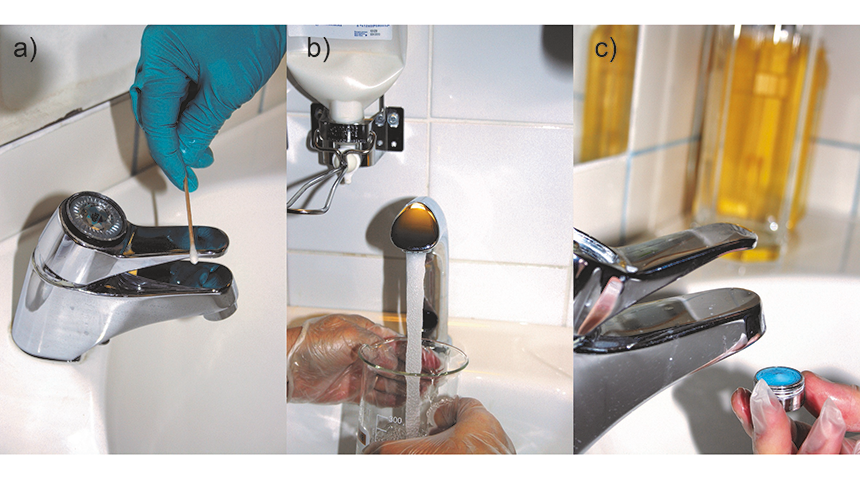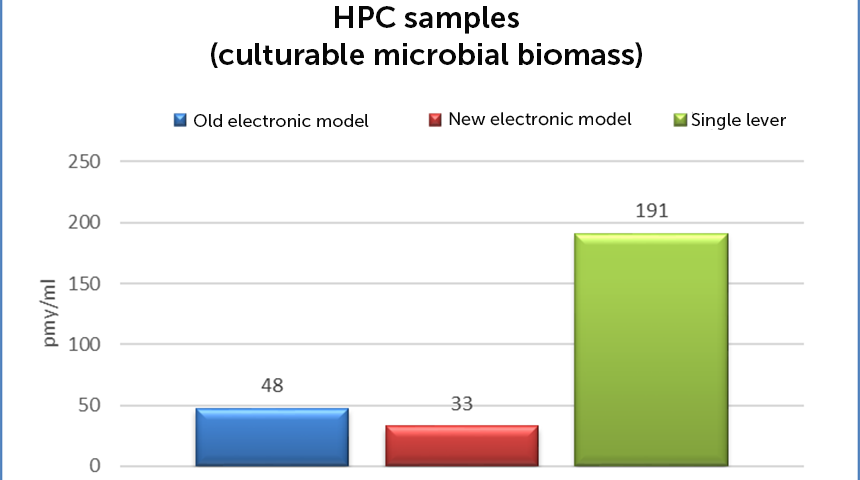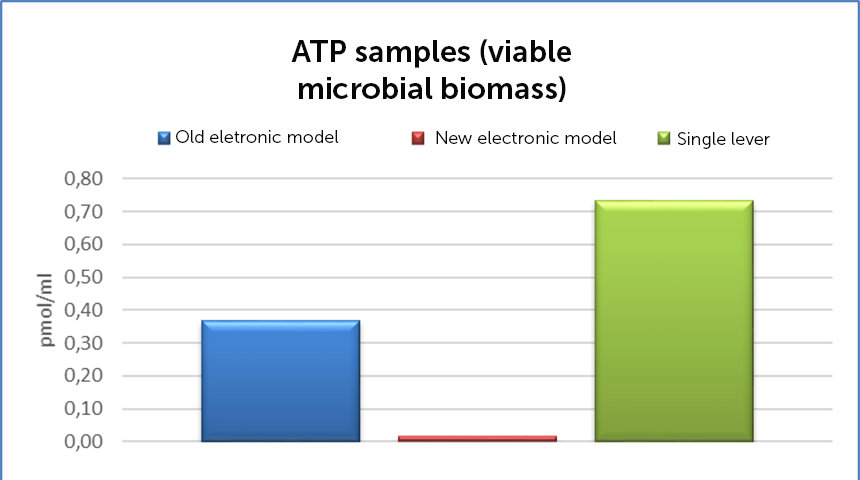
In 2008, the Nordic Water and Materials Institute carried out a faucet research to study the impact of faucets to hospital hygiene. The research was implemented in a large Finnish university hospital where traditional lever faucet and two different electronical touchless faucets were compared. Surface, water, and biofilm (faucet aerator) samples were taken from the faucets (Fig. 1). The faucets were chosen from as similar conditions as possible i.e. from the same or similar wards. The research was funded by the Regional Council of Satakunta and Oras Ltd.
The studied faucets were Oras Electra 6150G (new model), Oras Electra 6204 (old model) and Oras Safira 282 (lever). The structural difference between the two electronic faucets is the mixing place of cold and warm water; in the new model (6150G) water is mixed in the faucet part, in the old model (6204) water is mixed ca. 50 cm before the faucet part.
The samples were analyzed for concentrations of microbiological parameters and parameters showing technical quality of drinking water. Microbiological analyses included Escherichia coli, Clostridium difficile, Pseudomonas aeruginosa, Klebsiella sp., coliform bacteria, intestinal enterococci, Legionella spp., heterotrophic plate count (HPC, representing culturable microbial biomass), and adenosine triphosphate (ATP, representing viable microbial biomass). All used analysis methods were either internationally or nationally standardized or scientifically published.
The results from the surface samples taken from the outer surfaces of the faucets pointed out that the amount of viable microbial biomass on touchless faucets was lower than on lever faucets. So, on lever faucet surfaces, there are more traces of human contacts i.e. contamination than on electronic touchless faucet surfaces. The results prove that regarding surface hygiene the touchless faucets are superior compared to lever faucets (Fig. 2a and 2b).
Water from the faucets as well as the incoming water to the hospital building were of similar microbiological and chemical quality so the hospital water distribution network did not affect the quality of water.
Additionally, interesting results were achieved from the biofilm samples (aerators) through HPC and ATP analysis. The results show that new model electronic faucets have less culturable and viable microbial biomass in the aerators.
Individual microbe species were present either in very small amounts or not at all. No significant differences between faucet types were detected.
Similar results of the microbiological quality of the new model electronic faucets (water mixing in the faucet part) have been introduced in other international scientific researches as well. The electronic touchless faucets have far better surface hygiene than lever faucets and there is no difference in water quality between these two types of faucets. (Bédard et al. 2016, Charron et al. 2015).
Conclusions
- Touchless electronic faucets had significantly less microbial biomass on the surfaces than lever faucets. On studied surfaces, microbes were mainly from human origin, so the results might be used when achieving appropriate hand hygiene.
- Water from the faucets was chemically of uniform quality, no differences between faucet types.
- New model electronic faucets had less microbial biomass in aerators than old model electronic or lever faucets.
- The hygiene levels of water distribution network and surfaces in a hospital are among the most important things to prevent nosocomial infections. Electronic touchless faucets could further assist to achieve the targeted hygiene levels.
Riika Mäkinen, Senior Researcher, PhD
Satakunta University of Applied Sciences, WANDER Nordic Water and Materials Institute
Bédard E, Prévost M, Déziel E. 2016. Pseudomonas aeruginosa in premise plumbing of large buildings. MicrobiologyOpen 5: 937–956. DOI: 10.1002/mbo3.391
Charron D, Bedard E, Lalancette C, Laferriere C, Prevost M. 2015. Impact of electronic faucets and water quality on the occurrence of Pseudomonas aeruginosa in water: a multi-hospital study. Infect Contr Hosp Epidemiol. 36(3), 311-319. DOI: 10.1017/ice.2014.46
Mäkinen R., Miettinen I.T., Pitkänen T., Kusnetsov J., Pursiainen A., Kovanen S., Riihinen K., Keinänen-Toivola M.M. (2013) Manual faucets induce more biofilms than electronic faucets. Canadian Journal of Microbiology, 59(6), 407–412. DOI: 10.1139/cjm-2013-0131

Figure 1: Surface, water, and biofilm (faucet aerator) samples

Figure 2a: HCP samples

Figure 2b: ATP samples







